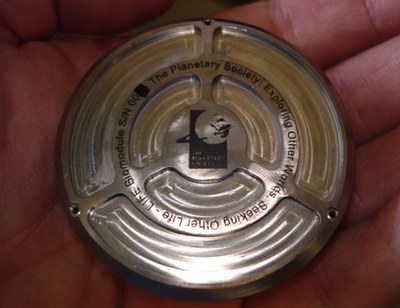Phobos sample return launches tomorrowby Lou Friedman
|
| Partial success will be good enough to signal Russia’s return to planetary exploration and perhaps provide added resources to the nascent but shaky plans of NASA and ESA to explore Mars together. |
The spacecraft is the heaviest solar system explorer ever (more than twice the second-heaviest, Cassini). It is carrying over 11 metric tons of fuel. Although its ultimate goal is to bring back 200 grams of Phobos soil, it carries more than 50 kilograms of scientific instruments for in-situ and remote measurements at Phobos. Included are no less than seven spectrometers, a microscope, visual imaging cameras, a long-wavelength radar, gravimeter, seismometer, and several instruments for studying the near-Mars environment. The manipulator to capture the soil samples and sampling system were major developments. There is considerable European participation in all of the science experiments, even those built in Russia.
The spacecraft arrives at Mars in October 2012 and will go into an initial orbit around the planet, from which it will deploy the Chinese spacecraft. Then the Phobos spacecraft will transfer to an intermediate orbit for a long period (weeks) of tracking and observations to gather data for the final approach and targeting of the spacecraft rendezvous and landing on the Martian moon. This is the time when the 1988 Phobos mission was lost. The landing, collection of the sample, and liftoff from Phobos are scheduled to be concluded by February or March 2013. The 11-kilogram return capsule is scheduled to reach Earth in August 2014, landing in the extraordinary environment of the Kazakhstan desert in the middle of summer. The return will be a high-speed direct entry to Earth with no parachutes. If all this happens, it will be amazing.
In the return capsule, isolated from the sample canister (in which scientists hope will be pieces of the Phobos regolith), will be the biological capsules of The Planetary Society’s LIFE and of the Institute of Biological and Medical Problems (IMBP) Anabios experiment. The LIFE is designed to test the theory of transpermia—the transfer of life from planet to planet—while Anabios will study the response of microorganisms to long-duration spaceflight in an experiment designed to be relevant to humans. Russian attention to this question is part of their long-term interest in human Mars exploration and, in fact, the group involved with this experiment is also part of the recently completed Mars500 project, which simulated aspects of the Martian expedition in an isolated Earth-based facility.
| Our experiment will test ideas about the possibility of life on Mars seeding Earth, not the other way around. |
Some concern about carrying living (albeit dormant) microbes to the vicinity of Mars were initially expressed by scientists properly concerned about contamination of Mars. The LIFE sample canister was built to withstand 4000 G’s of shock—strong enough to withstand an accidental entry or landing on Mars as well as the shock of landing back on Earth. Rigorous analysis and space agency reviews also showed that the probability of entry into Mars and subsequent release of any organisms was far lower than the limit dictated by international planetary protection protocols. Thus, our experiment will test ideas about the possibility of life on Mars seeding Earth, not the other way around.
Good luck to our Russian colleagues and to all the participants on this mission from around the world. (Or, as they say in Russian, chastleevava puti). On a personal note, I am gratified to be the only official US experimenter (principal investigator) on the mission, with our LIFE. Gratified, but disappointed that there isn’t more American involvement. Of course, I am only the “front man” for a wonderful team led by experiment manager Bruce Betts and an international group of participating biologists led by David Warmflash. We all thank the Russian scientists at the Space Research Institute (IKI) and IMBP and the engineering team at the Lavochkin Association for accommodating our privately-funded experiment and making our novel and first interplanetary test of transpermia possible.
